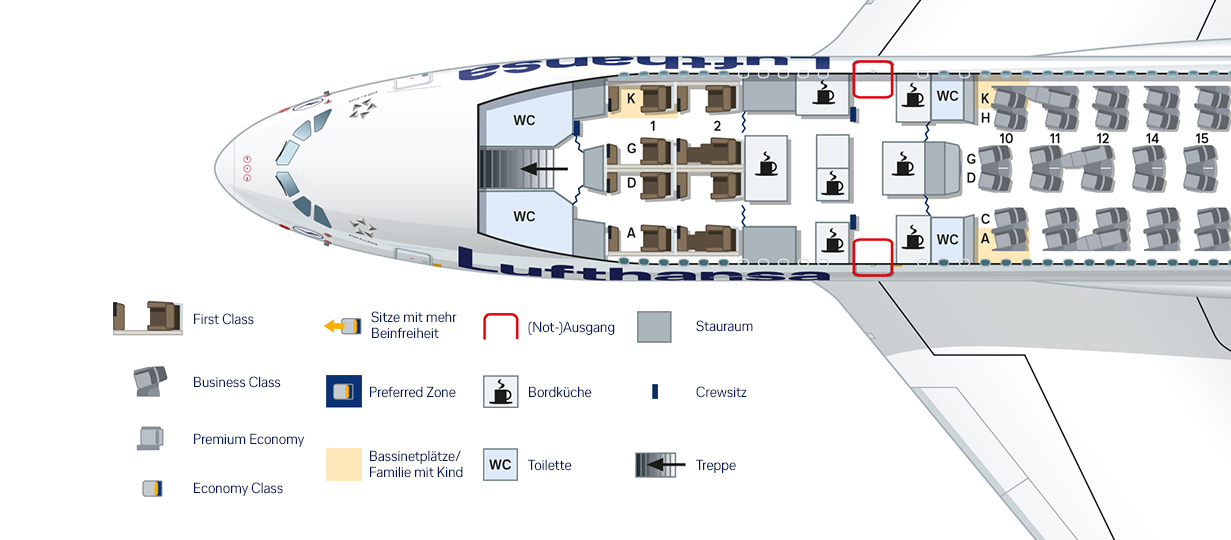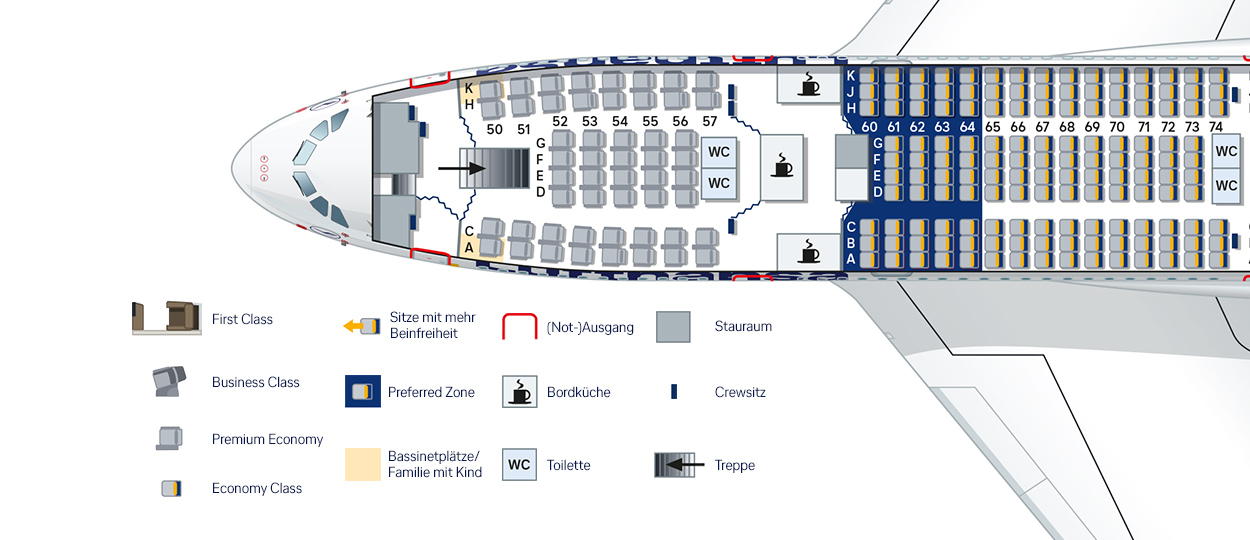
Airbus A380 Aircraft Overview and Seat Selection Guide

The Airbus A380 is the world’s only full-length double-deck, four-engine commercial aircraft. Designed by Airbus, it is the largest passenger aircraft ever built, with the capacity to carry more than 850 passengers in an all-economy configuration. The A380 is widely used on long-haul, high-demand international routes and is favored for its spacious cabin and in-flight comfort, making it ideal for long-distance travelers.
1. Airbus A380 Overview
- Aircraft Type: Ultra-large, four-engine, wide-body aircraft
- Length: Approximately 73 meters
- Maximum Range: Around 15,200 kilometers
- Typical Capacity: Varies by airline and configuration, from approximately 484 to 615 passengers
- First Commercial Flight: 2007
Common Cabin Configurations
Cabin Layout Type | Seat Count Range | Economy Class on Upper Deck |
Four-class (First/Business/Premium/Econ) | About 484 | No |
Three-class (First/Business/Economy) | About 489–519 | No |
Three-class (Business/Premium/Economy) | About 491 | No |
Two-class (Business/Economy) | About 615 | Yes (Economy on upper deck) |
Typical Routes Using the A380
Popular on long-haul routes such as Taipei, Hong Kong, or Singapore to London, Paris, Dubai, Sydney, Los Angeles, and New York.
2. Airbus A380 Cabin and Seating Configuration


Image Source: Lufthansa
Upper Deck
- Usually reserved for first class and business class
- In some two-class configurations, the rear upper deck includes economy class seats
Main Deck
- Primarily economy class
- Some carriers feature premium economy at the front section of the main deck
- Standard configuration is 3-4-3 in economy
Economy Class Seat Types
- Standard seats: Typically in the rear or mid-section
- Preferred seats: Located in the front of the economy section
- Extra legroom seats: Found in bulkhead rows (e.g., Row 31) or near emergency exits
3. Economy Class Seat Selection Tips (Based on Real-World Layouts)
Recommended Seats
Row 31
The first row of economy, offering the most legroom. Ideal for tall passengers. These are usually paid seats. Tray tables are in the armrests, and some versions may lack a window.
Row 61
Located just behind the emergency exit row with no seats in front. Provides excellent legroom. However, this row does not have windows and is near the crew galley.
Rows 74 and onward
Layout changes to 2-4-2 or 2-3-2. Window or aisle seats here feel more spacious. Ideal for couples or those preferring a quieter cabin. Be aware of more noticeable turbulence at the back of the plane.
Row 75
The final row. Window seats are available, but recline may be limited. Good for passengers needing close access to lavatories.
Seats to Avoid
Row 40
Located near the lavatories at the end of the wing section. Prone to foot traffic, noise, and limited views.
Row 72
A windowless row. Avoid if you prefer natural light or views.
Center seats (D/E/F/G)
Provide no outside view. Suitable for group travelers but less comfortable for solo flyers.
4. View and Photography Tips
For Engine or Wing Shots
- Forward windows (e.g., Rows 20–25) offer views of the engines and fuselage
- Rear windows (e.g., Rows 68–73) offer views of the wing and winglet
Selecting Based on Sunlight Direction
To enjoy sunrises or sunsets from the window, select your side based on flight direction:
- Northbound flights
- Morning: left side (A seats)
- Evening: right side (K seats)
- Morning: left side (A seats)
- Southbound flights
- Morning: right side (K seats)
- Evening: left side (A seats)
- Morning: right side (K seats)
Recommended window-aligned rows (may vary slightly by aircraft): 32, 35, 38, 40, 44, 63, 66, 73
5. Seat Selection Process and Membership Guidelines
Step 1: After booking
- Seat selection becomes available immediately
- Standard members must pay for all seats
- Silver-tier members can select standard seats
- Gold and Platinum members (and companions) can select preferred seats and two-seat configurations
Step 2: Online check-in (48 hours before departure)
- Use the airline’s website or app to select or change seats
- The system might preassign a seat, which you can manually change before finalizing check-in
- At this stage, standard and preferred seats are usually free
Step 3: Airport counter (within 3 hours of departure)
- If your preferred seat is unavailable online, try requesting a seat change at the check-in desk
6. Current Airbus A380-800 (A388) Direct Flight Routes
Flight Number | Aircraft Type | Departure Airport | Arrival Airport |
|---|---|---|---|
EK384 | Airbus A380-800 | Suvarnabhumi Airport, Bangkok (BKK / VTBS) | Hong Kong International Airport (HKG / VHHH) |
EK352 | Airbus A380-800 | Dubai International Airport (DXB / OMDB) | Singapore Changi Airport (SIN / WSSS) |
EK342 | Airbus A380-800 | Dubai International Airport (DXB / OMDB) | Kuala Lumpur International Airport (KUL / WMKK) |
OZ203 | Airbus A380-800 | Los Angeles International Airport (LAX / KLAX) | Incheon International Airport (ICN / RKSI) |
EK225 | Airbus A380-800 | Dubai International Airport (DXB / OMDB) | San Francisco International Airport (SFO / KSFO) |
7. Summary
The Airbus A380 is a flagship aircraft known for its space, comfort, and stability. Its flexible cabin configurations provide a wide range of seating options across different airlines and routes. Whether you're looking for more legroom, unobstructed views, quiet zones, or convenience, understanding the A380’s cabin layout and choosing your seat wisely can significantly enhance your travel experience.
Seat Selection Guide for Popular Airbus and Boeing Aircraft
- Airbus A380 Seat Map & Aircraft Overview
- Airbus A320 Seat Map & Aircraft Overview
- Airbus A350-900 Seat Map & Aircraft Overview
- Boeing 737 Seat Map & Aircraft Overview
- Boeing 747-400 Seat Map & Aircraft Overview
- Boeing 787-9 Seat Map & Aircraft Overview
- Airbus A320 NEO Seat Map & Aircraft Overview
- Airbus A321 NEO Seat Map & Aircraft Overview
- Airbus A380-800 Seat Map & Aircraft Overview
- Airbus A359 Seat Map & Aircraft Overview
- Airbus A321 Seat Map & Aircraft Overview
- Airbus A330-300 Seat Map & Aircraft Overview
- Boeing 787-10 Seat Map & Aircraft Overview
- Boeing 737 MAX Seat Map & Aircraft Overview
- Boeing 737-800 Seat Map & Aircraft Overview
- ATR72 787-10 Seat Map & Aircraft Overview
